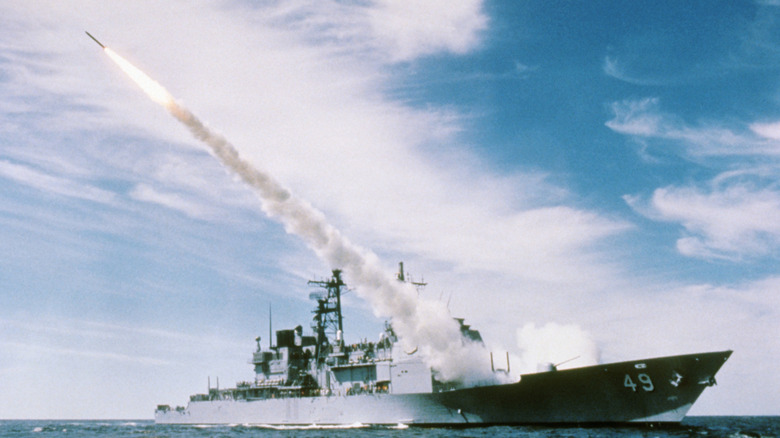How Anti-Submarine Rockets Work To Neutralize Their Target
Because of the specialized nature of submarines, a distinct military strategy called anti-submarine warfare, or ASW, was created to counter them. Its primary objective is to defend ships and allied assets by identifying, locating, and eliminating enemy submarines, using sonar, aircraft, dedicated submarines, and formidable weaponry. One of the most effective armaments used are anti-submarine rockets, which is known as a "Standoff" weapon. A Stand Off weapon is built to hit targets from a distance, allowing the launch platform the ability to evade the targets' defenses.
Anti-submarine rockets, as the name suggests, are designed to attack and destroy submarines. They're typically vertically launched from surface ships into the sky toward their target before falling into the water then, as a torpedo, acquires its target. Because of the threat submarines pose, several of the most powerful navy destroyers in the world are armed with anti-submarine rockets.
There are several components for anti-submarine rockets. The RUR-5 system, for example, primarily uses the Mk 112 octuple launcher, which can have a firing radius of 360 degrees depending on its placement. For the rocket, the RUR-5 uses a missile that acts as the delivery vehicle for the payload and is powered by a solid-propellant rocket motor. The torpedo payload is located in the front half of the fuselage, which is either the Mark 44 or Mark 45 acoustic homing torpedoes, but it can also be fitted with the W44 nuclear depth charge.
Lethal and efficient weapons platform
The origins of anti-submarine rockets date back to World War II, when the hedgehog and mousetrap were used. These were categorized as ahead-throwing projectors, meaning they fired projectiles like torpedoes ahead of the ship to intercept submarines before they could attack. By 1952, the Navy developed a new long-range ASW weapon system called the Rocket Assisted Torpedo, or RAT. It was created as a response to the increased range of ASW sonar systems that the U.S. Navy was using.
Submarines are designed with advanced technology to be as stealthy as possible, making them difficult to detect. However, ships, aircraft, and even drone systems work together to detect, track, and eventually destroy submarines using a combination of sensors and detection technology such as sonar, magnetic anomaly detectors, and electronic warfare tools. Once detected, the platforms can launch depth charges, anti-submarine rockets, torpedoes, and/or missiles to neutralize the threat.
Submarine and anti-submarine warfare are in a continuous arms race, where each side is trying to defeat the other through better detection, tracking, and weaponry. Now more than half a century old, anti-submarine rockets have advanced enough to include a vertically launched version. These developments are driven by technological advancements and the need to counter the continuing evolution of submarines and naval warfare. Because of its proven effectiveness, the anti-submarine rocket remains in demand and will likely continue as an integral weapon in ASW warfare for the foreseeable future.

